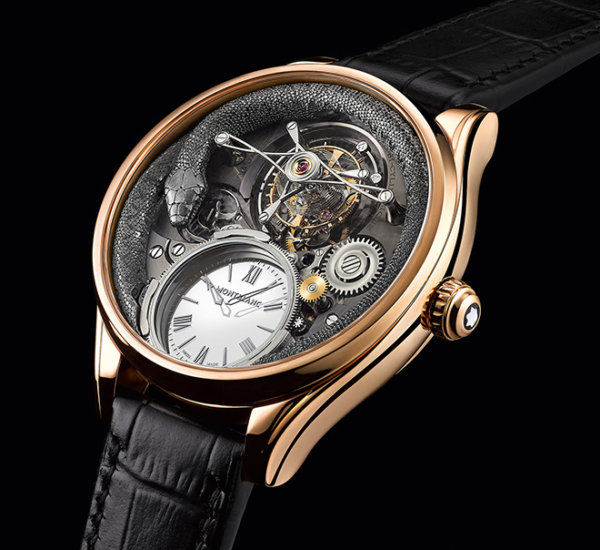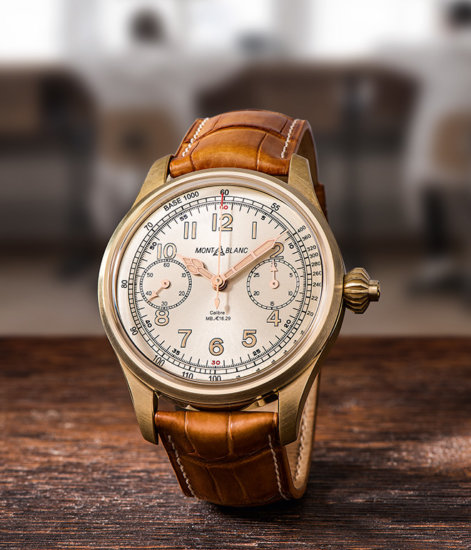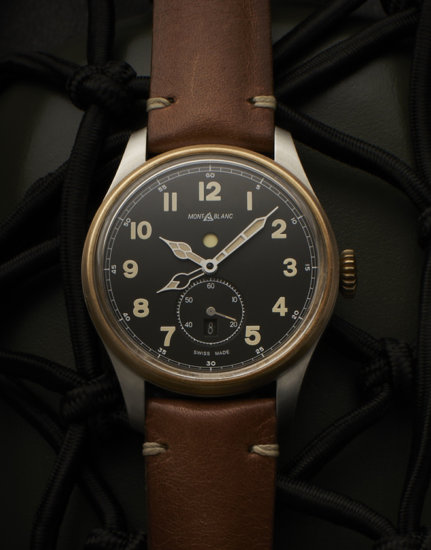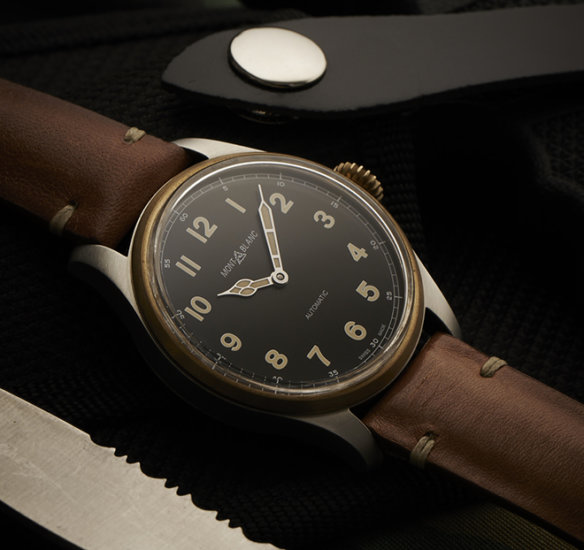Inside Manufacture Minerva: Home of Montblanc 1858 Collection
Adapting a vintage design for the modern age is right up Montblanc’s alley, thanks to its two manufactures that offer both traditional and cutting edge approaches to watchmaking.

Montblanc Villeret Tourbillon Bi-Cylindrique 110 Years Anniversary Limited Edition
In the pantheon of Roman gods, Janus is the one who presides over beginnings, transitions, and endings. Time itself is part of his domain, and Janus was often depicted with two faces – one gazed back at the past, while the other looked into the future. Montblanc shares a striking similarity to Janus in that both bridge the past and future: the maison constantly seeks to break new ground, yet keeps a keen eye on its heritage, both to protect it and to draw inspiration from it. This trait is characterised, quite fittingly, by the brand’s timepieces.
Dawn of a New Manufacture
Montblanc only started producing timepieces in 1997. This was admittedly a late start, especially in comparison to other manufactures that already boasted over a century of watchmaking heritage by then. Considering how the maison has managed to establish itself as a bona fide manufacture with both mass market and haute horlogerie offerings within two decades, however, it is clear that the length of time is but one factor in determining the relative success that a brand has in this field.

Montblanc’s Le Locle Manufacture
Montblanc’s initial foray into timepieces was centred on Le Locle, where it established its watchmaking operations. The choice was an easy one to make – the little town nestled in the Jura Mountains had a long history of watchmaking, and already depended on it as its chief economic activity from the 1840s. As Montblanc was part of the Richemont Group, it could also count on technical support from sibling brands such as IWC and Jaeger-LeCoultre. From the get-go, however, the maison was determined to maintain its autonomy in design and product positioning. To that end, its initial offerings heavily mirrored the fountain pens that the brand was then better known for – gold cases and black dials recalled classics such as the Montblanc Meisterstück 149, and drew an instant link between the two product universes. The stylised six-pointed white star was also a recurring motif and appeared in places such as the crown and the seconds hand. Over time, Montblanc expanded its range of watches to include women’s collections such as the ultra-feminine Star Lady, and sportier lines like the Timewalker. The brand’s ability to master both the traditional and the avant-garde was evident from the start – even as it pushed the envelope with technical details such as the use of DLC in some sports watches, it also offered classic designs in lines like the Star collection.
Acquiring Minerva, Transforming into Villeret
Montblanc received a major boost to its watchmaking capabilities in 2006, when the Richemont Group acquired Minerva. The Villeret-based manufacture was nearly 150 years old by then, and the terms of the deal included unlimited rights to its calibres, existing ébauches, machines, tools, and even the building itself. Considering that Minerva did produce its own watches, it was certainly possible to establish the manufacture as a distinct brand within the Richemont Group’s portfolio, albeit one that operated on a smaller scale. The ultimate decision, however, was to integrate it with Montblanc.

Inside Manufacture-Minerva, now known as Villeret, Home of Montblanc 1858 Collection.
Minerva was only named as such in 1929; the company was founded in 1858, and was initially an établisseur that merely assembled finished components into complete watches. It reached a major milestone in 1902 with the introduction of its first in-house movement and, by 1910, was producing around a dozen different ébauches alongside chronographs and stopwatches. As an entity, Minerva changed hands several times and, as was common in the past, had its products marketed under many different brands, such as the now defunct Rhenus and Tropic. There were common threads running through its history though. For one, despite the ownership changes Minerva remained private until its acquisition by the Richemont Group. This gave the manufacture an independence that also shaped its development – automation, for instance, was never considered, which kept the quantities of movements and watches produced relatively modest. In turn, Minerva’s limited scale safeguarded its independence, as it was too small to attract the attention of conglomerates keen on acquiring watchmaking assets. Ownership aside, the company’s winning of the timing contract for the 1936 Winter Olympic Games also set an important precedent by firmly establishing chronographs, stopwatches, and measuring instruments as the second key pillar of the business, in addition to watches. This business unit kept the company afloat during the Quartz Crisis, as it supplied stopwatches and other measuring devices to clients outside the watch industry.

The vaunted 500 hours test within Montblanc’s Le Locle facility
Under Montblanc, Minerva was rebranded as the maison’s Villeret manufacture. This addition meant that Montblanc now had two synergistic watchmaking assets under it –the state-of-the-art Le Locle manufacture that produces tens of thousands of watches annually, and the traditional Villeret manufacture with an expertise in movement development and production honed over one and a half centuries.
Indeed, the maison took full advantage of this, and eventually separated the watchmaking functions among the two manufactures to play to each’s strengths. The Villeret manufacture now handles in-house movement development and prototyping, as well as the assembly of all in-house movements from small to high complications. Selected timepieces that are produced within the manufacture’s high watchmaking atelier are encased there as well, with each watch cased up by the same watchmaker that assembled its movement. Finally, the Villeret manufacture also produces hairsprings. This fairly uncommon capability that has allowed Montblanc to offer atypical oscillators, such as the Villeret Tourbillon Bi-Cylindrique 110 Years Anniversary Limited Edition watch, which uses two concentric cylindrical hairsprings (one set inside the other) within the tourbillon escapement.

Hairspring production remains a key competency of the Villeret manufacture
The Le Locle manufacture, on the other hand, handles the watchmaking functions outside of movement development and production. These range from the initial design and prototyping work, to the production of cases, dials, and hands, to final assembly and quality control. Montblanc’s Laboratory Test 500 Hours, which subjects all Montblanc watches with in-house movements to a battery of tests totalling 500 hours, is also conducted at Le Locle. Finally, with the recent establishment of a dedicated business unit for watches, even the staff involved in marketing and other such functions are now based there.
Minerva – Villeret – Le Locle – Montblanc: Managing Fine Watchmaking Know-how
With the cutting edge design and production capabilities of one manufacture to complement the rich heritage of the other, Montblanc has been able to flex its watchmaking muscles and offer vintage inspired watches with decidedly modern twists. The recent three additions to the maison’s 1858 collection epitomises this, beginning with the 1858 Chronograph Tachymeter Limited Edition. This timepiece is the flagship of the three new watches, and harks back to the early days of chronograph technology with its monopusher layout. The modern self-winding chronograph movement with two pushbuttons, such as the ubiquitous Valjoux 7750, is the result of several cumulative developments, which the monopusher chronograph predates. Instead of two pushers, the sole pusher here starts, stops, and resets the chronograph sequentially, and is thus unable to total the elapsed time for separate events by stopping and restarting the chronograph – a quaint limitation today, but the norm in the past.

Left: An earlier Montblanc 1858 Chronograph Tachymeter Limited Edition in steel. Right: Its successor, 1858 Chronograph Limited Edition in Bronze
Choice of complication aside, the watch’s design also alludes to the past, specifically Minerva’s history of producing watches for military use. The importance of keeping accurate time in a military context should be easy to understand. Coordinating troop movements to predetermined times, for one, would maintain the element of surprise. A chronograph with a telemeter scale, on the other hand, would allow an artillery battery’s commander to gauge the distance to the enemy. Pilots, too, relied on chronographs when navigating, by timing the various legs of a flight pattern. The 1858 Chronograph Tachymeter Limited Edition’s design is based on an earlier reference in blue, which was itself derived from a pilot’s monopusher chronograph Minerva made in 1932. Note how the cathedral hands, vintage typeface for the hour indexes, and oversized onion crown have all been maintained as throwbacks to the original.

The 1858 Chronograph Tachymeter Limited Edition’s bronze case has been matched with a champagne-coloured dial
In lieu of an exact facsimile, however, Montblanc opted to update the original’s design while preserving its vintage military vibe, with the most striking change being the usage of bronze instead of steel. Bronze was, of course, never used in any vintage watch – the material was only introduced as a case material in the mid-1990s. The alloy immediately imparts an aged look to the watch that will intensify over time as it acquires a patina. Lest one is worried about this choice of material, rest assured that the variant used here is aluminium bronze. This alloy will start to develop a dark, even patina after two to three weeks of wear, but lack the pitting or green discolouration commonly observed in standard bronze and brass. Meanwhile, the timepiece’s case back is bronze-coloured titanium, so skin allergies are a non-issue. The choice of bronze is certainly atypical for a timepiece positioned at this level. Davide Cerrato, managing director of Montblanc’s watch division, agreed. “It’s clearly not a watch for everyone. If you think you’re buying a gold watch, then you’ll be disappointed because it will get darker – we’ve communicated this very clearly. For the collector who wants a watch with a patina, however, it’s the perfect timepiece.”
The 1858 Chronograph Tachymeter Limited Edition’s bronze case has been matched with a champagne-coloured dial, which is yet another anachronism. Period correct military watches would, of course, have high contrast dials in either black or white for maximum legibility. This was also deliberate. According to Cerrato, this dial colour was chosen to impart a monochromic look, for an even heavier touch of vintage appeal. The crystal also remains domed like the original, although its material has been updated from acrylic to sapphire. The finishing touch on the front of the watch is the vintage styled Montblanc logo, which currently appears on all 1868 collection timepieces.

The Montblanc MB M16.29 calibre here features impeccable hand finishing on every single component and there is much to see thanks to the chronograph’s horizontal clutch layout
Flip the watch around, and the transparent case back presents a feast for the eyes. The MB M16.29 calibre here features impeccable hand finishing on every single component – frankly a given that’s expected of the Villeret atelier – and there is much to see thanks to the chronograph’s horizontal clutch layout. The V-shaped chronograph bridge and arrow-shaped component, signatures of the Minerva manufacture, are also present here, with the latter executed at one end of the chronograph blocking lever. In a first for the brand, the movement bridges and mainplate have been plated with red gold, to complement the hue of the bronze case. The greatest visual delight is served up by the large balance wheel, which beats at a leisurely 18,000vph. This oscillation frequency is inherently less accurate compared to movements beating at higher frequencies, and thus demands much more work to reach similar levels of chronometric performance. The consequence is of this is that every watch becomes a luxury product through and through given the time lavished on its movement.
The Rest of the Montblanc 1858 Collection
The 1858 Automatic Dual Time and 1858 Automatic were conceived to be accessible translations of the 1858 Chronograph Tachymeter Limited Edition’s concept, and have been priced accordingly. The most striking differences lie in their designs: in lieu of full bronze cases, the watches are bi-colour instead, with stainless steel providing contrast to their bronze bezels and crowns. The two watches also have high contrast dials that are closer to the original’s in spirit.

1858 Automatic Dual Time
Of course, the movements housed with the two watches also differ from the 1858 Chronograph Tachymeter Limited Edition. In fact, the small complication housed within the 1858 Automatic Dual Time, a second time zone display with day/night indicator, is also anachronistic, as it had only been developed in the 1950s. Cerrato described this watch as “almost a pre-GMT”, yet again demonstrating Montblanc’s deft touch in combining the best of elements from different time periods. The Automatic Dual Time’s MB 29.19 calibre is an in-house development, and is capable of “hiding” the second hour hand below the first should the watch’s wearer not require it. Finally, the 1858 Automatic rounds out the trio as the most affordable timepiece among them, with a simple two-hand layout that only displays the time.
Despite having designs rooted in a military chronograph produced during the interwar period, the three timepieces have been refreshed with modern elements, and look like perfect blends between a modern watch and its predecessor from a century ago. What’s even more impressive is how they can effortlessly put a dressy twist on the rugged tool watch aesthetic – none of these timepieces will be out of place under a suit in the boardroom. Cerrato opined that the right combination of elements can render such categorisations moot, because “[a] good design transcends such categories”. The three watches here have certainly done that.

1858 Automatic
Words by Jamie Tan.
From: Luxuo.







